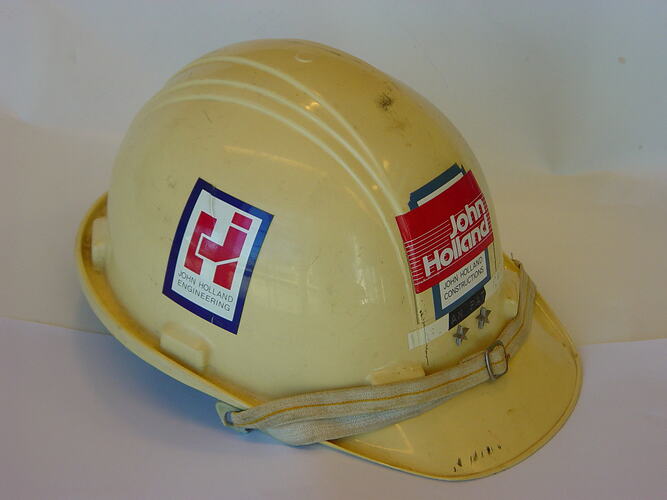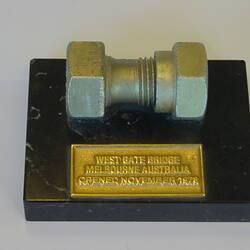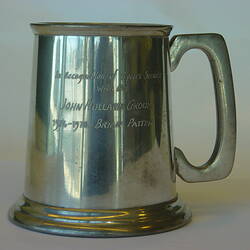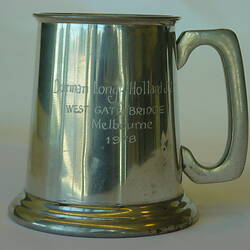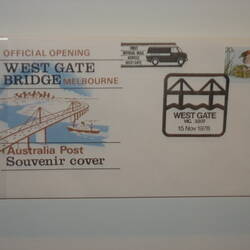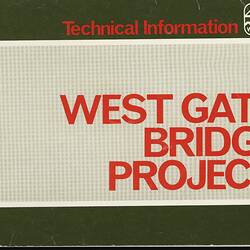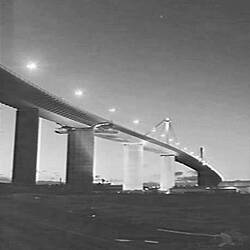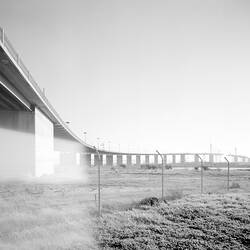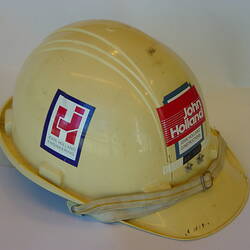Summary
Hard hat or safety helmet used by the donor's father Harold Bryan Patten during the period 1974-1978 when he worked as an estimator for John Holland Constructions on the completion of the West Gate Bridge in Melbourne.
Manufactured by The Commonwealth Industrial Gases Ltd (CIG), Melbourne, Australia, circa 1974.
Physical Description
Cream coloured adjustable safety hat made under Australian Patents 209252, 246705 & UK Patent 998695. Head Clearance 1 ¾ inches; Sizes 6 ½ - 7 ¾ inches. Has stickers reading "John Holland" and "John Holland Constructions" on front, also remains of name tag reading " . AN PAT ." and two stars. Sticker on right-hand side reads: "JOHN HOLLAND ENGINEERING".
Significance
This safety hat was used by Harold Bryan Patten during the period 1974-1978 when he worked as an estimator for John Holland Constructions on the completion of the West Gate Bridge. Mr Patten was born on 15 February 1928 and trained as an engineer before becoming involved in the construction industry. The three other items were presented to Mr Patten on his retirement from John Holland following the opening of the bridge in November 1978. Mr Patten died in about 2005.
Built between 1968 and 1978, the Westgate Bridge has become an integral part of Melbourne's freeway network and a vital east-west transport link that connecting Melbourne's western suburbs and the Princes Freeway route to Geelong and beyond to the centre of Melbourne. Designed to replace the Williamstown Ferry that had operated across the lower Yarra between Fisherman's Bend and Newport since 1931, it was constructed by the Lower Yarra Crossing Authority and initialled opened as a tollway - the first 'user pays' road in Melbourne for over a century.
Since it first began to rise above the mudflats of the lower Yarra, the West Gate Bridge has become a key local landmark which Melburnians quickly took to heart and it remains the city's best recognised international engineering landmark. Towering high above the river flats with its sweeping approach spans and 102-metre high twin cable-stay towers, it is Victoria's highest and second-longest bridge, with an overall length of 2,582 metres, including approach spans. Its innovative design was of international significance, at the time, with the world's longest cable-stayed steel girder span.
On 15 October 1970, the West Gate Bridge made international headlines when at 11.50 am the partially completed 367-ft (112 m) box girder span between piers 10 and 11 collapsed. In a matter of seconds 2,000 tonnes of steel and concrete crashed 50 metres onto the river mudflats bringing down two of the bridge piers and killing 35 workers, with 18 others seriously injured. The disaster remains Australia's worst industrial accident in terms of lives lost and became a pivotal moment in Melbourne's post-war history.
A Royal Commission appointed to investigate the disaster sat for 80 days and interviewed 52 witnesses, reporting in July 1971 with the conclusions that the failure was jointly attributable to short-comings in the original design calculations undertaken by the structural designers, Freeman Fox & Partners, of London, and to the unusual erection methods employed by the principal construction contractors, World Services & Construction, although the immediate chain of events that lead to the collapse was caused by poor communication between the designers and contractors and between the contractors their site engineers and construction foreman.
Following design alterations construction of the West Gate Bridge was finally completed in 1978 at a cost of $202 million - over eight times the original estimate. While Sydney-siders had become used to paying tolls for decades to cross their Harbour Bridge, the tolls initially charged on all private & commercial vehicles (60c for cars & $2 for trucks) crossing the West Gate Bridge were unpopular with Melburnians and after just six years were abolished early in the first term of Cain Labor Government. By 1979, the bridge was carrying 22,000 vehicles/day. By 1998 some 570 million vehicle crossings had been made over the bridge and it was carrying 140,000 vehicles a day.
More Information
-
Collection Names
-
Collecting Areas
-
Acquisition Information
Donation from Mr Greg Patten, Ms Julia Church - Italian Historical Society (Co.As.It), 06 Feb 2007
-
Date Manufactured
Commonwealth Industrial Gases (CIG), New South Wales, Australia, circa 1974
-
User
Mr Harold Bryan Patten, Westgate Bridge, Greater Melbourne, Victoria, Australia, 1974-1978
-
Inscriptions
On front: John/Holland/JOHN HOLLAND/CONSTRUCTIONS/...[Illegible.]AN PAT[Illegible.]... On side: JOHN HOLLAND/ENGINEERING
-
Classification
-
Category
-
Discipline
-
Type of item
-
Object Measurements
30.2 cm (Length), 23.3 cm (Width), 16.8 cm (Height)
-
References
Bill Hitchings, "West Gate", 1979. Report of Royal Commission into the Failure of the West gate Bridge, Victoria, C.H. Dixon, Government Printer, Melbourne, 1971. West Gate Memorial website: [Link 1]
-
Keywords
